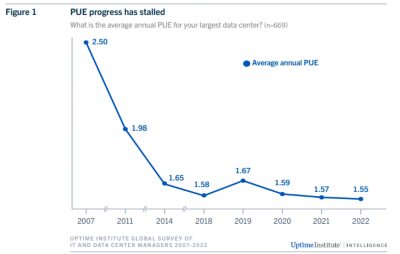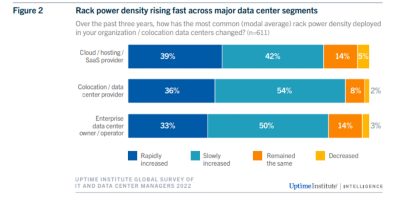Synopsis
Sustainability pressures are growing. Most operators expect carbon emissions reporting requirements soon — yet many are unprepared.
• Outages are becoming more expensive and are still too frequent but the number of operators reporting a significant outage is down slightly
• Many cloud applications are vulnerable to outages, despite growing confidence in cloud’s suitability for mission-critical workloads
• Future efficiency gains will need to focus on IT power, requiring additional metrics to supplement power usage effectiveness (PUE)
• Data center equipment vendors are caught between high demand and lingering supply chain problems. Most vendors deliver with delays
• Attracting and retaining qualified staff remains highly problematic for many operators.
The Uptime Institute Global Data Center Survey 2022 reveals an industry that is growing, dynamic and increasingly resilient. Spending on data centers and related services is strong, despite persistent staffing shortages, supply chain delays and other obstacles. Creating a more environmentally sustainable footprint is a major and growing focus as operators brace for heightened scrutiny, new regulations and reporting requirements.

Industry benchmarks
Power usage effectiveness (PUE) and rack power density are two major metrics the data center industry uses to track progress toward greater facility efficiency. The simplicity and wide adoption of these metrics are their strengths, but their scope does not extend to the IT infrastructure. Typically, IT accounts for the largest proportion of a data center’s energy use and other environmental impacts, yet IT operational efficiency is largely not quantified. PUE is in stasis – for now Since its introduction in 2007, PUE has become the de facto standard metric for data center efficiency. Despite long-acknowledged limitations to its scope (such as IT efficiency and trade-offs with resiliency and water), PUE helps operators track the energy efficiency of their facilities over time. When backed up by a large sample size, PUE is also the most useful proxy to illustrate trending in facility efficiencies of the global data center sector.
Uptime has been tracking PUE for 15 years. Survey respondents’ average annual PUE in 2022 was 1.55 (see Figure 1), which means that, in aggregate, their data centers expend 55% as much energy on cooling, power distribution and ancillary facility functions as on IT. This is consistent with the average PUE trend observed by Uptime in recent years — improvement slowed markedly in 2014, with only marginal gains

Rise of rack densities accelerate
Uptime has been closely tracking data center power densities as a key design and operational metric for many years. Increases in modal (most common) rack power have been slow for several years, with no major shift from the typical 4 kilowatt (kW) to 6 kW cabinets, even at flagship data centers. Emerging compute-hungry workloads, such as the application of artificial intelligence (AI) in analytics and engineering simulations, have up to now failed to significantly push up modal rack power. Uptime does not track the innumerable racks spread across all small computer rooms; if we did, modal rack power would likely be considerably lower still. Population averages tend to reveal trends slowly, hiding underlying dynamics. But in a marked uptick to previous readings, more than a third of data center operators surveyed say their densities have rapidly increased in the past three years, with only 4% decreasing. There are some, albeit small, differences between enterprises, colocation operators and IT services providers, such as cloud, hosting and software as a service (SaaS), as shown in Figure 2

